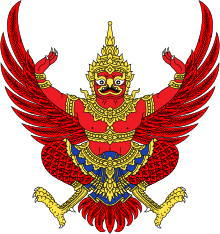Ministry of Finance (Thailand)
|
กระทรวงการคลัง Krasuang Kan Khlang | |
|
"The Seal of the Bird of Paradise" used as the Ministry's seal. | |
| Ministry overview | |
|---|---|
| Formed | 14 April 1875 |
| Preceding agencies |
|
| Jurisdiction | Government of Thailand |
| Headquarters | Rama VI Road, Bangkok |
| Annual budget | 199,174,066,600 baht (2016) |
| Ministers responsible |
|
| Website | www.mof.go.th |
The Ministry of Finance (Thai: กระทรวงการคลัง; rtgs: Krasuang Kan Khlang; abbreviated as MOF) is a cabinet ministry in the Government of Thailand.
Considered to be one of the country's most important ministries, the Ministry of Finance has many responsibilities over public finance, taxation, the treasury, government properties, operations of government monopolies, and revenue-generating enterprises. The ministry is also vested with the power to provide loan guarantees for the governmental agencies, financial institutions, and state enterprises.[1]
The head of the ministry is the Minister of Finance (Thai: รัฐมนตรีกระทรวงการคลัง). He is a member of the Cabinet of Thailand and therefore appointed by the King of Thailand at the advice of the prime minister. The Minister of Finance (2016) is Mr Apisak Tantivorawong.[2]
History
The ministry has existed in form since the 15th century during the Ayutthaya Kingdom. Then, the ministry was called the "Kromma Khlang" (Thai: กรมคลัง) and eventually upgraded to “Krom Phla Khlang” (Thai: กรมพระคลัง, sometimes written as "Berguelang" or "Barcelon" by foreign authors). The "Phla Khlang" or minister had wide ranging powers include those of taxation, trade, monopolies, tributes, and even foreign affairs.
Most of these features were retained during the Rattanakosin era. In 1855 King Mongkut signed the Bowring Treaty with the United Kingdom. The treaty exposed Siam to modern trade and international commerce; the king was forced to set customs duty rate at no more than three percent; the country was at a disadvantage, but international trade grew. Soon the king was forced to set up a customs house (Thai: ศุลกสถาน) and the Royal Mint to deal with new challenges.
During the reign of King Chulalongkorn (Rama V), the ministry took its present shape. The king issued a royal decree in 1873 consolidating all powers and agencies under one ministry with a more focused portfolio. He appointed one of his uncles, Prince Maha Mala Pamrabporapat as its first minister. The ministry finally came into its own in 1933 via the Civil Service Reform Act of 1933. The Royal Treasury Ministry was then changed to the Ministry of Finance which now consists of 10 departments and 14 state enterprises.[3]
Departments
Administration
- Office of the Minister (Thai: สำนักงานรัฐมนตรี)
- Office of the Permanent Secretary (Thai: สำนักงานปลัดกระทรวงการคลัง)
Dependent departments
The Revenue Department
During the reign of King Rama V, the Revenue Department (Thai: กรมสรรพากร) was organised as two separate departments: the External Revenue Department and the Internal Revenue Department. The External Revenue Department was responsible for the collection of taxes and duties outside Bangkok and was under the Royal Treasury Ministry, today's Ministry of Finance. Due to personnel shortages, district and sub-district chief officers were assigned to collect taxes and duties, and the department was subsequently brought under the Ministry of Interior. Unlike the External Revenue Department, the Internal Revenue Department was responsible for the collection of taxes and duties within greater Bangkok (including areas in Pathum Thani, Nonthaburi, and Samut Prakan and was under the Ministry of Metropolis. This department was established following the advice of Mr W. A. Graham who was the Ministry of Metropolis's comptroller at the time. The two departments were finally combined and named the Revenue Department. It was officially established on 2 September 1915, and Phrya Indra Montri Sri Chandra Kumar (F. H. Giles) became its first director-general.
The Revenue Department collects, administers, and develops six types of taxes: personal income tax, corporate income tax, value added tax, specific business tax, stamp duties, and petroleum income tax. These taxes combined account for more than 80 percent of total government revenue. The department operates 12 regional revenue offices, 119 area revenue offices, and 850 area revenue branch offices throughout the country as well as 14 bureaus at its headquarters. The department also collaborates with international organizations including the International Monetary Fund, the World Bank, and the fr:International Bureau of Fiscal Documentation to ensure international best practices for tax administration and policies.
- The Fiscal Policy Office (Thai: สำนักงานเศรษฐกิจการคลัง)
- The Treasury Department (Thai: กรมธนารักษ์)
- The Comptroller General Department (Thai: กรมบัญชีกลาง)
- The Customs Department (Thai: กรมศุลกากร)
- The Excise Department (Thai: กรมสรรพสามิต)
- The Public Debt Management Office (Thai: สำนักงานบริหารหนี้สาธารณะ)
- The State Enterprise Policy Office (Thai: สำนักงานคณะกรรมการนโยบายรัฐวิสาหกิจ)
State enterprises[4]
- The Government Lottery Office
- Thailand Tobacco Monopoly
- Government Savings Bank
- Government Housing Bank
- Krung Thai Bank Public Company Limited
- Bank for Agriculture and Agricultural Cooperatives
- Liquor Distillery Organization (Excise Department)
- Playing Cards Factory (Excise Department)
- Export-Import Bank of Thailand
- Small Business Credit Guarantee Corporation
- Secondary Mortgage Corporation
- Student Loan Fund
- Dhanarak Asset Development Company Limited
See also
- Economy of Thailand
- Thailand Customs
- Thai baht
- Thai lottery
- Bank of Thailand
- Stock Exchange of Thailand
- Cabinet of Thailand
- List of Government Ministers of Thailand
- Government of Thailand
- Taxation in Thailand
References
- ↑ http://www2.mof.go.th/government_agencies.htm
- ↑ "MR. APISAK TANTIVORAWONG". Ministry of Finance. Retrieved 15 April 2016.
- ↑ http://www2.mof.go.th/history.htm
- ↑ "State Enterprises". Ministry of Finance. Retrieved 10 June 2015.
External links
- Ministry of Finance - Official Website in Thai
- Ministry of Finance - Official Website in English
.png)
